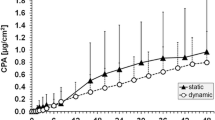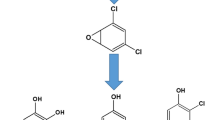Abstract
N-Methyl-2-pyrrolidone (NMP) is a versatile organic solvent frequently used for surface cleaning such as paint stripping or graffiti removal. Liquid NMP is rapidly absorbed through the skin but dermal vapour phase absorption might also play an important role for the uptake of the solvent. This particular aspect was investigated in an experimental study with 16 volunteers exposed to 80 mg/m3 NMP for 8 h under either whole-body, i.e. inhalational plus dermal, or dermal-only conditions. Additionally, the influence of moderate physical workload on the uptake of NMP was studied. The urinary concentrations of NMP and its metabolites 5-hydroxy-N-methyl-2-pyrrolidone (5-HNMP) and 2-hydroxy-N-methylsuccinimide (2-HMSI) were followed for 48 h and analysed by gas chromatography–mass spectrometry (GC–MS). Percutaneous uptake delayed the elimination peak times and the apparent biological half-lives of NMP and 5-HNMP. Under resting conditions, dermal-only exposure resulted in the elimination of 71 ± 8 mg NMP equivalents as compared to 169 ± 15 mg for whole-body exposure. Moderate workload yielded 79 ± 8 mg NMP (dermal-only) and 238 ± 18 mg (whole-body). Thus, dermal absorption from the vapour phase may contribute significantly to the total uptake of NMP, e.g. from workplace atmospheres. As the concentration of airborne NMP does not reflect the body dose, biomonitoring should be carried out for surveillance purposes.





Similar content being viewed by others
References
ACGIH (American Conference of Governmental Industrial Hygienists) (2007) Threshold limit values and biological exposure indices. Signature Publications, ISBN 978-1-882417-69-8
Åkesson B (2001) N-methyl-2-pyrrolidone. Concise International Chemical Assessment Document 35, World Health Organization, Geneva, ISBN 9 241 53035 9
Åkesson B, Jönsson BAG (1997) Major metabolic pathway for N-methyl-2-pyrrolidone in humans. Drug Metab Dispos 25:267–269
Åkesson B, Jönsson BAG (2000) Biological monitoring of N-methyl-2-pyrrolidone using 5-hydroxy-N-methyl-2-pyrrolidone in plasma and urine as the biomarker. Scand J Work Environ Health 26:213–218
Åkesson B, Carnerup M, Jönsson BAG (2004) Evaluation of exposure biomarkers from percutaneous absorption of N-methyl-2-pyrrolidone. Scand J Work Environ Health 30:306–312
Akrill P, Cocker J, Dixon S (2002) Dermal exposure to aqueous solutions of N-methylpyrrolidone. Toxicol Lett 134:265–269
Anundi H, Lind ML, Friis L, Itkes N, Langworth S, Edling C (1993) High exposures to organic solvents among graffiti removers. Int Arch Occup Environ Health 65:247–251
Anundi H, Langworth S, Johanson G, Lind ML, Åkesson B, Friis L, Itkes N, Söderman E, Jönsson BAG, Edling C (2000) Air and biological monitoring of solvent exposure during graffiti removal. Int Arch Occup Environ Health 73:561–569
Bader M, Keener SA, Wrbitzky R (2005) Dermal absorption and urinary elimination of N-methyl-2-pyrrolidone. Int Arch Occup Environ Health 78:673–676
Bader M, Rosenberger W, Rebe Th, Keener S, Brock TH, Hemmerling H, Wrbitzky R (2006a) Ambient monitoring and biomonitoring of workers exposed to N-methyl-2-pyrrolidone (NMP) in an industrial facility. Int Arch Occup Environ Health 79:357–364
Bader M, Wrbitzky R, Blaszkewicz M, van Thriel Ch (2006b) Human experimental exposure study on the uptake and urinary elimination of N-methyl-2-pyrrolidone (NMP) during simulated workplace conditions. Arch Toxicol 81:335–346
Beaulieu HJ, Schmerber KR (1991) M-Pyrol™ (NMP) use in the microelectronics industry. Appl Occup Environ Hyg 6:874–880
Brooke I, Cocker J, Delic JI, Payne M, Jones K, Gregg NC, Dyne D (1998) Dermal uptake of solvents from the vapour phase: an experimental study in humans. Ann Occup Hyg 8:531–540
Carnerup MA (2004) Analysis, metabolism, effects and biological monitoring of N-methyl-2-pyrrolidone (NMP). Thesis, Faculty of Medicine, Lund University, Sweden
Carnerup MA, Spanne M, Jönsson BAG (2006) Levels of N-methyl-2-pyrrolidone (NMP) and its metabolites in plasma and urine from volunteers after experimental exposure to NMP in dry and humid air. Toxicol Lett 162:139–45
Cocker J, Akrill P, Bagon D, Roff M, Warren N (2004) Biological monitoring of exposure to N-methyl-2-pyrrolidone during graffiti and paint removal. In: 6th International symposium on biological monitoring in occupational and environmental Health, Heidelberg
DFG (Deutsche Forschungsgemeinschaft) (2006) N-Methyl-2-pyrrolidon. In: Greim H (ed) Gesundheitsschädliche Arbeitsstoffe. Toxikologisch-arbeitsmedizinische Begründungen von MAK-Werten. Suppl 41. Wiley, Weinheim
DFG (Deutsche Forschungsgemeinschaft) (2007) List of MAK and BAT values. Commission for the Investigation of Health Hazards of Chemical Compounds in the Work Area. Report No. 43, Wiley, Weinheim
HSE (Health and Safety Executive) (1997) N-Methyl-2-pyrrolidone. Risk assessment document. EH72/10, ISBN 0717615286, HSE Books, Sudbury
Jones K, Cocker J, Dodd LJ, Fraser I (2003) Factors influencing the extent of dermal absorption of solvent vapours: a human volunteer study. Ann Occup Hyg 47:145–150
Jönsson BAG, Åkesson B (2003) Human experimental exposure to N-methyl-2-pyrrolidone (NMP): toxicokinetics of NMP, 5-hydroxy-N-methyl-2-pyrrolidone, N-methylsuccinimide and 2-hydroxy-N-methylsuccinimide (2-HMSI), and biological monitoring using 2-HMSI as a biomarker. Int Arch Occup Environ Health 76:267–274
Keener SA, Wrbitzky R, Bader M (2006) Human volunteer study on the influence of exposure duration and dilution of dermally applied N-methyl-2-pyrrolidone (NMP) on the urinary elimination of NMP metabolites. Int Arch Occup Environ Health 80:327–334
Kežić S, Mahieu K, Monster AC, de Wolff FA (1997) Dermal absorption of vaporous and liquid 2-methoxyethanol and 2-ethoxyethanol in volunteers. Occup Environ Med 54:38–43
Korinth G, Göen Th, Lakemeyer M, Broding HC, Drexler H (2003) Skin strain and its influence on systemic exposure to a glycol ether in offset printing workers. Contact Derm 49:248–254
Langworth S, Anundi H, Friis L, Johanson G, Lind ML, Söderman E, Åkesson B (2001) Acute health effects common during graffiti removal. Int Arch Occup Environ Health 74:213–218
Loizou GD, Jones K, Akrill P, Dyne D, Cocker J (1999) Estimation of the dermal absorption of m-xylene vapor in humans using breath sampling and physiologically based pharmacokinetic analysis. Toxicol Sci 48:170–179
Rawson BV, Cocker J, Evans PG, Wheeler JP, Akrill PM (2005) Internal containtion of gloves: routes and consequences. Ann Occup Hyg 49:535–541
Riihimäki V, Pfäffli P (1978) Percutaneous absorption of solvent vapors in man. Scand J Work Environ Health 4:73–85
Saillenfait AM, Gallissot F, Langonne I, Sabate JP (2002) Developmental toxicity of N-methyl-2-pyrrolidone administered orally to rats. Food Chem Toxicol 40:1705–1712
Saillenfait AM, Gallissot F, Morel G (2003) Developmental toxicity of N-methyl-2-pyrrolidone in rats following inhalation exposure. Food Chem Toxicol 41:583–588
Ursin C, Hansen CM, Van Dyk JW, Jensen PO, Christensen IJ, Ebbehoej J (1995) Permeability of commercial solvents through living human skin. Am Ind Hyg Assoc J 56:651–660
Wilkinson SC, Williams FM (2002) Effects of experimental conditions on absorption of glycol ethers through human skin in vitro. Int Arch Occup Environ Health 75:519–527
Wrbitzky R, Angerer J (1998) N,N-dimethylformamide—influence of working conditions and skin penetration on the internal exposure of workers in synthetic textile production. Int Arch Occup Environ Health 71:309–316
Acknowledgments
This study was financially supported by grants of the NMP Producers Group, c/o Bergeson & Campbell, Washington DC, USA.
Author information
Authors and Affiliations
Corresponding author
Rights and permissions
About this article
Cite this article
Bader, M., Wrbitzky, R., Blaszkewicz, M. et al. Human volunteer study on the inhalational and dermal absorption of N-methyl-2-pyrrolidone (NMP) from the vapour phase. Arch Toxicol 82, 13–20 (2008). https://doi.org/10.1007/s00204-007-0230-5
Received:
Accepted:
Published:
Issue Date:
DOI: https://doi.org/10.1007/s00204-007-0230-5




